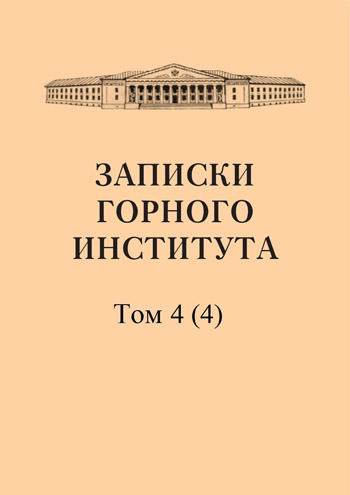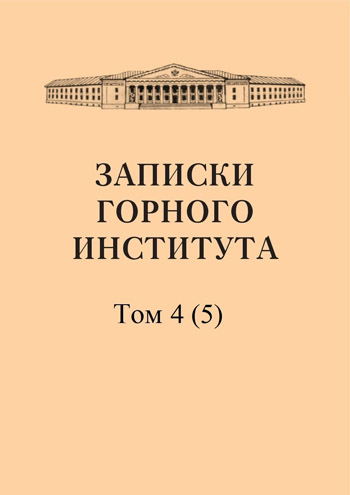-
Date submitted1913-06-27
-
Date accepted1913-08-17
-
Date published1913-12-01
Trofim Vasilievich Efimov. Obituary
- Authors:
- A. Lychagin
Suddenly, a student of the Mining Institute, Efimov (born in 1872), died in the carriage. Efimov entered the Mining Institute in 1903, when out of 700 who passed competitive exams, 93 people were admitted, of whom 25 had a university education. This means that according to the competitive exams, with secondary education, 68 people entered. This year I was going to graduate from the Institute. I worked 20 hours a day, but finally broke down...
-
Date submitted1913-06-13
-
Date accepted1913-08-16
-
Date published1913-12-01
Additional remark to the article by A.K. Boldyrev “One of the properties of tangent circles” On the properties of spheroprimes of vectorial circles
- Authors:
- E. S. Fedorov
I take this opportunity to note for the thousandth time the advantages of the method of new geometry, the theorems of which know no exceptions, but always have perfect generality. This author has already given the proof of this theorem, which I communicated to him, using the method of new geometry. It seems to me that A.K.’s theorem is much more expedient and simpler. Boldyrev should be formulated as follows (see article). Theorem of A.K. Boldyrev in a generalized form, using the method of new geometry, reveals one of the interesting properties of spheroprims of vectorial circles.
-
Date submitted1913-06-02
-
Date accepted1913-08-28
-
Date published1913-12-01
Crystallographic and optical study of campheroxime C10 H16 NHO
- Authors:
- G. G. Kell
The right and left-hand rotating pure varieties of campheroxime and their mixtures were studied; between the latter there is an inactive difference that does not rotate the plane of polarization.
-
Date submitted1913-06-19
-
Date accepted1913-08-26
-
Date published1913-12-01
On the closedness theorem in the theory of trigonometric series
- Authors:
- N. M. Krylov
A very simple proof was given by Prof. V.A. Steklov, expressed by the formula, but ше still differs significantly from various proofs of the same theorem given by prof. V. A. Steklov and, rather in terms of ideas, approaches the proof of Prof. Hurwitz (based on the Cesaro-Fejer method of ariemetic averages), having, it seems to me, the advantage of greater simplicity, since it is based on the application of the theorem on term-by-term integration of trigonometric series, which itself is a special case of the closedness theorem.
-
Date submitted1913-06-30
-
Date accepted1913-08-17
-
Date published1913-12-01
Strict balancing of mining areas
- Authors:
- I. M. Bakhurin
Strict balancing of mine polygons using the least squares method does not occur in practice at all. The reason for this is the complexity of the calculations associated with balancing using the strict method. Meanwhile, in practice, it is very often not at all interesting to know either the corrections of individual measurements, or even the corrections of the coordinates of individual points and azimuths of stations, but it can be very desirable to know the correction of the coordinates of any one point and the correction of the azimuth of any one station, which, say, will serve source for surveying a new polygon or which are obtained based on another survey, and the question is about balancing the nodal point.
-
Date submitted1913-06-07
-
Date accepted1913-08-03
-
Date published1913-12-01
Mercury fulminate crystals
- Authors:
- V. M. Derviz
Anhydrous crystals of this substance are obtained by the action of ethyl alcohol on a solution of mercury nitrate according to the formula (see article). They are crystallized from a hot aqueous solution. This salt can be looked at as a salt of fulminate acid or carbidoxime. The measured crystals were extracted from a dusty powder, in which, however, due to the extreme shine of the microscopic crystals, shiny points are still visible, partly due to the mixed drops of mercury.
-
Date submitted1913-06-03
-
Date accepted1913-08-06
-
Date published1913-12-01
Crystallographic measurements of abietic acid
- Authors:
- M. F. Silant'ev
This is a measurement of abiethic acid with a melting temperature of +143 ° C., obtained by O. O. Koshelev in the laboratory of Prof. Chugaev from a solution in ethyl alcohol in the form of colorless transparent crystals. The crystals belong to the rhombic system of the gynohexagonal type and have a lamellar appearance with the most strongly developed face (0101) and are almost always elongated in one of two directions: either along the [1000] axis or along the [0121] axis. On all observed crystals, the (0101) faces were strongly and completely irregularly curved. See the figure and measurement results in the article.
-
Date submitted1913-06-16
-
Date accepted1913-08-10
-
Date published1913-12-01
Crystallization of some organic compounds
- Authors:
- S. E. Aivazov
In this article, the previous calculation system is replaced by a new one proposed by E.S. Fedorov. Anyone who has used crystallographic literature, even if corrected, such as Groth's chemical crystallography, knows that the inconsistency and often the complete confusion of the data make it impossible to draw up a diagram, and therefore to take advantage of the work that the author spent on the research. Such complete helplessness to restore the crystalline complex caused the creation of a new system of calculations using bipolar coordinates by which, with the slightest misunderstanding in these angles, reality can be restored.
-
Date submitted1913-06-19
-
Date accepted1913-08-11
-
Date published1913-12-01
One of the properties of tangent circles
- Authors:
- A. K. Boldyrev
We have two equal mutually tangent circles O1 O2. We have a straight line AB, tangent to both, and a new circle C, tangent to both data. We assert that the point of intersection of these two tangents, i.e. points D and E, as well as the point of tangency of two given circles, i.e. point F, are equally distant from point G, i.e. from one of the meeting points of the circle C and straight CF. Proof of Prof. E.S. Fedorov.
-
Date submitted1913-06-06
-
Date accepted1913-08-18
-
Date published1913-12-01
Confocal populations
- Authors:
- E. S. Fedorov
With regard to the theory of confocal sets, the conclusion drawn shows that the set of surfaces derived from the imaginary hyperbola taken as the focal curve does not represent anything new, and was included in those that were derived on the basis of the real hyperbola. If we take into account that in the general case we have two focal curves connected by the main axis on two mutually perpendicular planes of symmetry, one of which is an ellipse and the other a hyperbola, that on the third plane of symmetry the focal curve can be neither an ellipse nor hyperbola, and, as it now turns out, an imaginary hyperbola, then it remains possible to assume only an imaginary ellipse, which is where the derivation of focal curves ends. In conclusion, we note that it is possible to derive involutions on the plane at infinity; since for it three normally conjugate rays are projected from any point, then the corresponding projectivity curve is an imaginary circle, and this is the case for all confocal populations in space.
-
Date submitted1913-06-21
-
Date accepted1913-08-11
-
Date published1913-12-01
Cubic crystals
- Authors:
- E. S. Fedorov
In this article I present, however possible, a complete list of crystals of the cubic system obtained to date. Here we are really dealing with a number of substances that are exceptional in their properties, like exceptional forms of the cubic system among all the others. When the list is compiled, this exclusivity is in the chemical composition of the substances What is striking is the possibility of dividing them into those few headings that form the basis of my presentation. Other features of the chemical composition of substances in this series will be discussed at the end of the article. I needed to compile this list simply because from those described, I could single out those crystals that cannot be determined by the method of crystal chemical analysis.
-
Date submitted1913-06-26
-
Date accepted1913-08-30
-
Date published1913-12-01
Construction of edges using symbols in hypohexagonal crystals
- Authors:
- E. S. Fedorov
The article raises the question of constructing edges from symbols in crystals for hypohexonal-type complexes, which has not yet been raised by anyone. Of course, it is extremely simple and similar to the solution for the cubic type. I have shown that in hypohexagonal complexes, the symbols of the edges are such that, in the special case of a hypohexagonal-isotropic complex, the indices of the edges and perpendicular faces are the same, as required by the theory of synclines (because in this case, the ellipsoid of synclines is a sphere).
-
Date submitted1913-06-06
-
Date accepted1913-08-27
-
Date published1913-12-01
About the projecting cones of stereographic projection
- Authors:
- E. S. Fedorov
In a gramstereographic projection, every plane is projected by an arc of a great circle, that is, an arc passing through two diametrically opposite points of the projection circle. This circle represents one circular section of a cone having a center at the point of convergence of the rays; another circular section of the same cone is the diametrical circle of a sphere at projected plane. Apparently, not a single crystallographer has yet noted that these projecting cones are not cones of a general nature, but are special cones, called cones of Pappus, who was the first to note their simple construction. Both special axes of the projecting cone are perpendiculars to both circular sections, that is, perpendiculars to both the given plane and the projection plane (see article).
-
Date submitted1913-06-13
-
Date accepted1913-08-13
-
Date published1913-12-01
More about special circles and spheres
- Authors:
- E. S. Fedorov
In these Notes (III 287) I devoted a note to this subject, in which I limited myself to only a complete derivation of the geometric images related here. The same conclusion, of course, could be produced in other ways, which should lead to identical results. All conoprims, for example, can be derived by a collinear transformation from circles, but also by notching two projective prime rays, and from elementary manuals it can be seen that the last example, if not more correct, is at least more visual, and in this sense simpler (see article). From the note mentioned at the beginning, it is clear that the existence of special circles and spheres brings great disruption to the ideas about the circle that have been established, not even for centuries, but for millennia. As it is proven in it, the idea of a center and equal radii must be completely eliminated from this concept."


